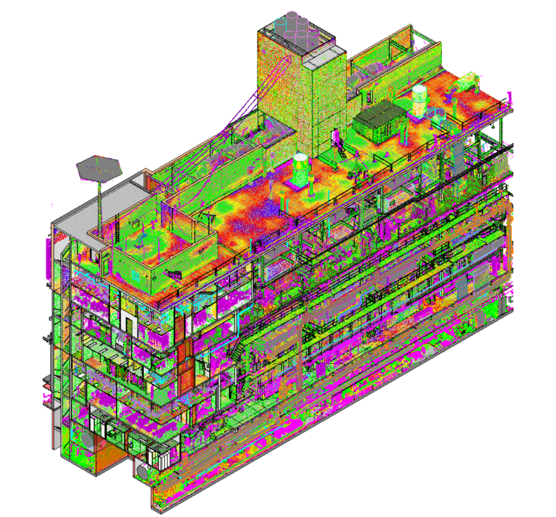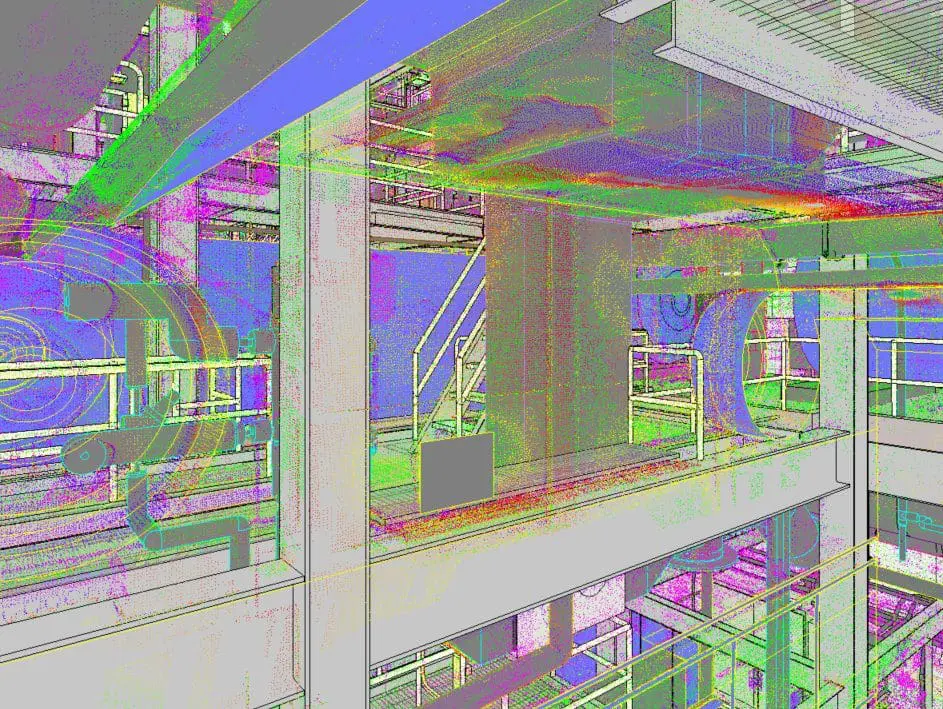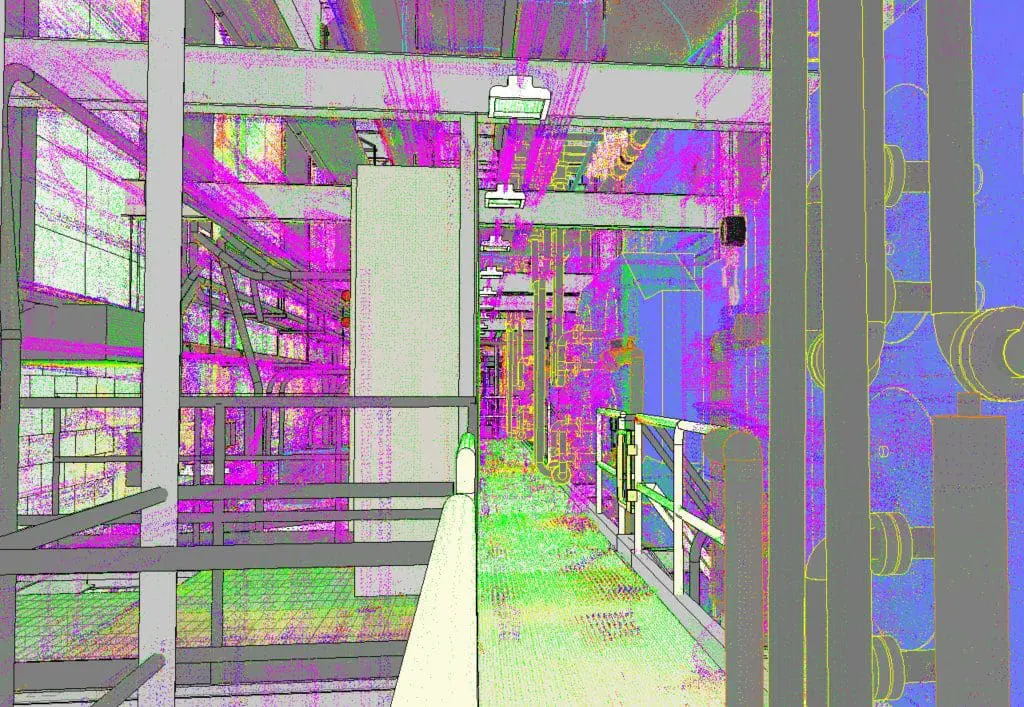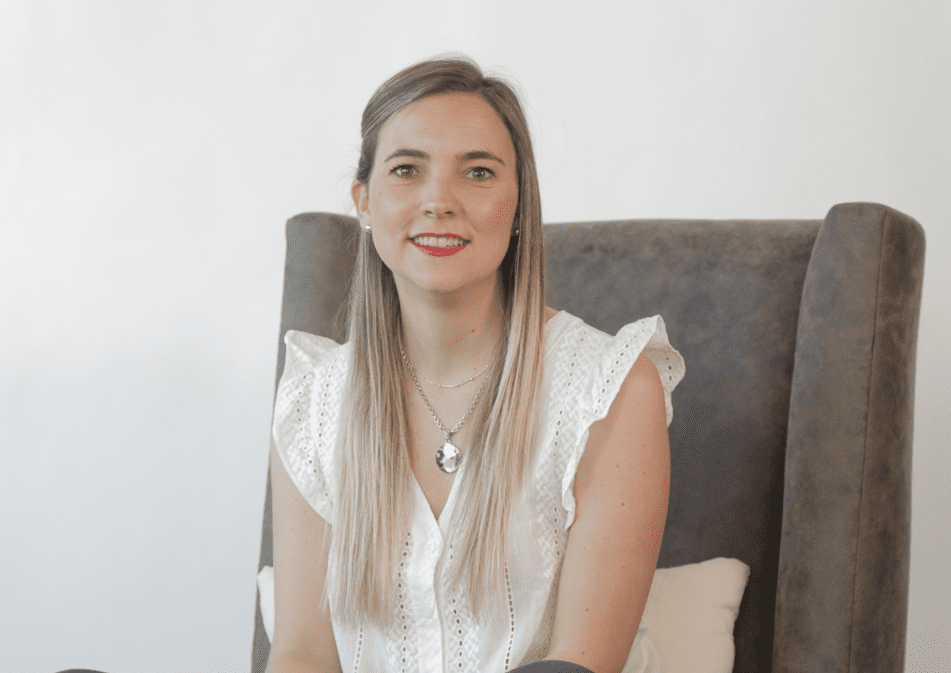You’ve seen how scan-to-BIM is changing the world of AEC, helping projects to streamline their processes and deliver better results faster. That’s why it’s so frustrating that few scan-to-BIM guides offer the real-world experience and insight you need to get started.
We caught up with Mariana Jimenez, Director of Scanning and Scan-to-BIM at ENG, to offer a different kind of beginner’s guide. We’ve drawn on her years of experience on dozens of projects with one of the largest and most respected BIM companies in the industry, all with the goal of offering you a true pro’s guide to scan-to-BIM.
What is Scan-to-BIM?
Scan-to-BIM is a process that uses point cloud data to model the existing, real-world conditions of a building or facility.
To perform scan-to-BIM, you would:
- Use 3D capture technologies, such as a laser scanner, to generate a point cloud of the asset
- Tracing that point cloud data with modeling software to create a 3D digital replica
For more information about this process, check out Scan-to-BIM University!

Scan-to-BIM generates a model that offers value to various stakeholders on any digital AEC project, Jimenez notes. She has seen scan-to-BIM models used throughout the entire AEC lifecycle, in the design, construction, and even operations stages.
And it doesn’t have to stop there. “Once your team has modeled all necessary features,” Jimenez explains, “you can take the process to the next level. Add additional metadata and attributes and you’ll create a digital twin.”
What are the real-world benefits of scan-to-BIM?
Having a detailed 3D model that accurately reflects the real-world conditions on site can bring a huge number of benefits. As Jimenez explains, scan-to-BIM will give you:
A Single Source of Truth
The model that acts as a common, accessible reference for everyone on the project, she says. All stakeholders can refer to the same data for their individual applications. And this significantly reduces the likelihood of misinformation and errors.
Increased Efficiency, Lower Costs
A majority of remodeling and retrofit projects still begin BIM work using pre-existing as-built documentation of the asset — and not models that they generated themselves. These pre-existing models are often inaccurate and incomplete.
The result? Stakeholders in the design and preconstruction phase begin their work with a faulty understanding of real-world conditions. This means the construction phase will often run into unforeseen conditions, causing delays and cost overruns that can seriously derail the project. “The application of scan-to-BIM data in the design and preconstruction phases can prevent most of these problems,” says Jimenez. “And that’s where the real value is.”
A Foundation for Automation
If you’re lucky enough to have an in-house development team, Jimenez says, a good scan-to-BIM process offers the data they’ll need to automate a significant portion of your project.
“As someone with strong project management background and passion for technology, it was incredibly fascinating when I started with ENG’s scan modeling division. I saw how much value the team was adding to our projects with even less effort each day, thanks to the new tools we were incorporating.”

The Hidden Challenges of Scan-to-BIM
Scan-to-BIM field work can present its own challenges, says Jimenez, and many of these are well covered in existing documentation and educational resources like ClearEdge3D’s Scan-to-BIM University.
But there are a few less obvious challenges you should keep in mind to set yourself up for success.
Underdefined Project Scope
“One of the biggest challenges I faced as a project manager was negotiating scopes with customers,” she says. Here’s the basic problem: Point clouds can capture everything, down to the smallest detail in the asset. So how much detail should the BIM model include?
Industry-standard definitions like BIM Forum’s LOD and other documents can help you to frame and monitor the project scope, she says. But you shouldn’t rely on them to fully clear up what needs to be included in the model.
“After a couple of setbacks and burned projects, I learned the importance of clearly defining and documenting all scope statements, and that inclusions or exclusions can make a project.” On top of that, she notes, a thorough kickoff meeting and direct communication can go a long way toward managing expectations with the end user during project development.
Internal Scope Creep
It’s also crucial to manage the scope internally, to make sure that your team is not doing more or less work than required by the project.
Since the point cloud can capture everything, Jimenez says, “it can be particularly challenging to coach and mentor your team to be mindful of the scope. Especially now with the growth in remote work.”
The answer is simple.
“Daily meetings, along with the implementation of agile methodologies help to deliver incremental value and identify deviations from scope early in the modeling process. This helps ensure that the project stays on track.”
Defining Quality
Understanding quality is one of the most challenging aspects of learning scan-to-BIM, says Jimenez. As you think about your projects, be very careful to consider issues like, “How do you define quality? What does good quality mean for your project? Who determines quality expectations if your client is unfamiliar with BIM procedures?”
And don’t get “quality” confused with accuracy, she says. Accuracy is just one among many aspects of a BIM model’s overall quality.
“Producing a high-quality model requires a significant amount of time, effort, and experience,” she warns, “and there are no established rules or thorough guidelines to follow out there.”
Advice for Getting Started with Scan-to-BIM
Given the challenges we’ve outlined above, you might wonder how best to get started with scan-to-BIM in your own AEC projects.
“My advice,” says Jimenez, “is to use webinars and conferences. These can be invaluable resources for benchmarking, learning what everyone else around is doing, and staying up to date on industry developments. Additionally, be sure to stay connected with others in your field, as technology is evolving at an unprecedented speed and there are always new tools out there that can make your everyday work easier.”
Lastly, Jimenez explains, don’t get too comfortable once you figure out what you’re doing. “Embrace change and challenge yourself and what you do, even if everything seems to be already working well.”

Wrapping Up
Jimenez believes that scan-to-BIM is a “truly rewarding” process and an exciting field to work in.
By capturing a building or other asset with a laser scanner and then using the point cloud to create a detailed 3D model, she says, you can bring huge benefits to any AEC project. You’ll provide a single source of truth for every stakeholder, reduce errors, increase efficiency, and limit budgets. You’ll even set the groundwork for future automation, which can keep your projects competitive in a world of ever-shrinking margins.
To ensure success, however, it’s important to keep an eye on the hidden challenges. Define project scope carefully, both externally with clients and internally with your own team. And be sure you define what “quality” actually means for your team and your projects specifically. That way you can be sure to deliver top-level BIM models time after time.
Lastly, she says, never stop learning. Scan-to-BIM is a dynamic field, so there are always new tools and methodologies to discover. And they just might help you take your projects to the next level.
About the Author
Mariana Jimenez
Director of Laser Scanning & Scan to BIM, ENG
Mariana Jimenez is a seasoned architect and BIM leader with deep expertise in laser scanning, project management, and digital construction workflows. As Director of Laser Scanning & Scan to BIM at ENG, she oversees one of the industry’s most advanced modeling teams, driving innovation and efficiency across complex AECO projects.
With a background that spans architecture, project management, and BIM leadership across multiple countries and cultures, Mariana brings a global perspective to every engagement. Since 2017, she has led ENG’s Reality Capture business unit, applying emerging technologies to real-world challenges in healthcare, industrial, manufacturing, education, and infrastructure.
Throughout her career, Mariana has contributed to iconic projects and lived in diverse cities including Denver, Los Angeles, Monaco, Santiago de Chile, and Mexico City, experiences that have shaped her professional outlook.
Her passion for technology and process optimization continues to guide her mission: to deliver accurate, constructible, and data-rich models that support better decision-making from design through operation.
